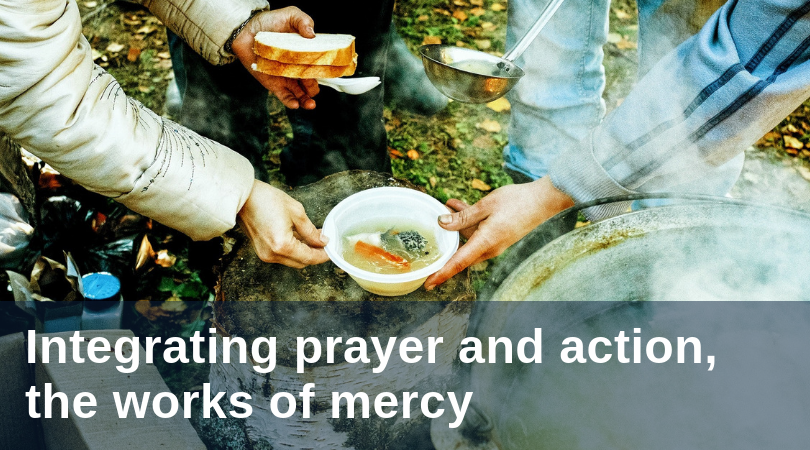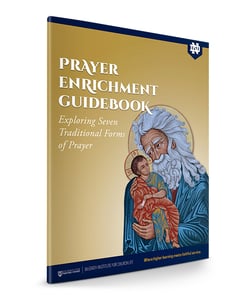
The works of mercy are loving acts of service and compassion directed towards the spiritual and material needs of our neighbors. At first glance, it may seem odd to include them alongside other forms of prayer, but we must remember that prayer and the Christian life are inseparable. The love of God that leads us into prayer is the same love that leads us to serve our neighbor. Consider the words of Jesus: “You shall love the Lord, your God, with all your heart, with all your soul, and with all your mind. This is the greatest and the first commandment. The second is like it: you shall love your neighbor as yourself” (Matthew 22:37-39).
The origins of the works of mercy
Most of the corporal works of mercy come to us from Matthew 25, where Jesus describes the separation of the sheep and the goats at the final judgment. The origins of the spiritual works of mercy as a complete list are harder to trace. However, both the corporal and spiritual works of mercy are practices well-supported by Scripture, tradition and the lives and writings of the saints.
Corporal Works of Mercy Spiritual Works of Mercy Feed the hungry Admonish the sinner Give drink to the thirsty Instruct the ignorant Clothe the naked Counsel the doubtful Visit the imprisoned Comfort the sorrowful Shelter the homeless Bear wrongs patiently Visit the sick Forgive all injuries Bury the dead Pray for the living and the dead
How the works of mercy relate to our prayer
“He ‘prays without ceasing’ who unites prayer to works and good works to prayer.” - Origen
This seven-week Prayer Enrichment Series culminates with the works of mercy because they are both the fruit and nourishment of the life of prayer (see 1 John 4:7-21). Far from being a to-do list of the Christian life, the works of mercy are the fruit that naturally stems from a loving relationship with God. Prayer fuels the works of mercy; love of God gives life to love of neighbor. As the first letter of St. John says, “We love because God first loved us,” and “anyone who loves God must also love their brother and sister” (1 John 4:19-21).
With this in mind, the works of mercy lead us to further union with God just as much as other forms of prayer,* and they are thus a practice for everyone to adopt.
*This is not to say that the works of mercy can replace prayer. Prayer and the Christian life are indeed inseparable, but they are not interchangeable; one cannot stand in for the other. Think of prayer as the root and stem of Christian life and the works of mercy as its fruit and branches.
How to live out our prayer through the works of mercy
Unlike the other forms of prayer outlined in this Prayer Enrichment Series, there is no step-by-step process for performing the works of mercy. Instead, the works of mercy should be as much a part of daily life as eating, sleeping or praying.
Unfortunately, we often treat the works of mercy as to-do lists. “Here are some things that I set aside a certain amount of time each week to accomplish. I’ll go to the soup kitchen one week. The hospital the next week.” And so on. It is indeed good to do these things (if you already do them, keep it up!), but approaching the works of mercy as a to-do list is a bit like claiming to be an artist because you paint for four hours a month. It’s compartmentalized and lacks integration.
Pope Francis has reminded us that the works of mercy are more comprehensive than that. Broadly conceived, they are not so much a particular rubric of actions as they are a way of life that cares for and shows mercy towards our brothers and sisters in all aspects of their existence and their need.
“The Christian life involves the practice of the traditional seven corporal and seven spiritual works of mercy. We usually think of the works of mercy individually and in relation to a specific initiative: hospitals for the sick, soup kitchens for the hungry, shelters for the homeless, schools for those to be educated, the confessional and spiritual direction for those needing counsel and forgiveness... But if we look at the works of mercy as a whole, we see that the object of mercy is human life itself and everything it embraces.”
- Pope Francis, Message for the celebration of the World Day of Prayer for the Care of Creation, 1 September 2016
Taking this to heart, the first place to practice the works of mercy is in “human life itself and everything it embraces.” For most people most of the time, this happens in the simple and hidden ways most appropriate to one's current particular vocation, like in the home or workplace. The real and concrete (not the hypothetical and ideal) is where the works of mercy will most naturally flow from and nourish our prayer. Do parents clothe the naked and feed the hungry? Do priests admonish sinners and comfort the sorrowful? Do colleagues bear wrongs patiently and forgive all injuries? Hopefully, the answer to each of these questions is a resounding yes!
Once we learn to enact the works of mercy in our daily activities (and also come to understand how we too are the recipients of daily works of mercy), our service in the more public or oft-considered works of mercy will become a deeper unfolding of an already merciful existence, rather than sporadic exercises in philanthropy. Caring for a sick stranger will be an extension of caring for an aging parent. Feeding hungry mouths at a soup kitchen will be an outgrowth of feeding hungry mouths at home. If we can integrate the works of mercy (both large and small) into the seamless garment of our life in Christ, we will be like real artists who draw and paint daily and then allow that daily creativity to spill out in more public and far-reaching works.
This integrated approach comes with a caveat: we cannot use it to excuse ourselves from serving the poor or seeking out those on the margins who do need our help. Treating our daily interactions as opportunities to show and receive mercy is a foundation for the more traditional acts of mercy, not a dispensation from them. An integrated life of prayer and mercy should propel us into the world and inflame our desire to enact God’s mercy. Fueled by prayer and a genuine love of God and neighbor, we will grow in our capacity to see the needs of the poor and marginalized and find the courage to act on their behalf.
Download the complete Prayer Enrichment Guidebook
 This article is the seventh installment of our seven-week Prayer Enrichment Series which comes directly from our free Prayer Enrichment Guidebook.
This article is the seventh installment of our seven-week Prayer Enrichment Series which comes directly from our free Prayer Enrichment Guidebook.
The Prayer Enrichment Guidebook introduces seven traditional styles of Catholic prayer, including lectio divina, the Examen and centering prayer.
The entry for each prayer practice introduced in this guidebook contains:
- A brief overview of the prayer practice
- Its origins
- Why one might practice it
- How one can practice it
This Prayer Enrichment Guidebook is an aid for all Christians to deepen their relationship with the Lord through new forms of prayer. It is an ideal supplement for Catholic teachers, catechists, ministers and anyone who seeks to encounter God in a new way.



